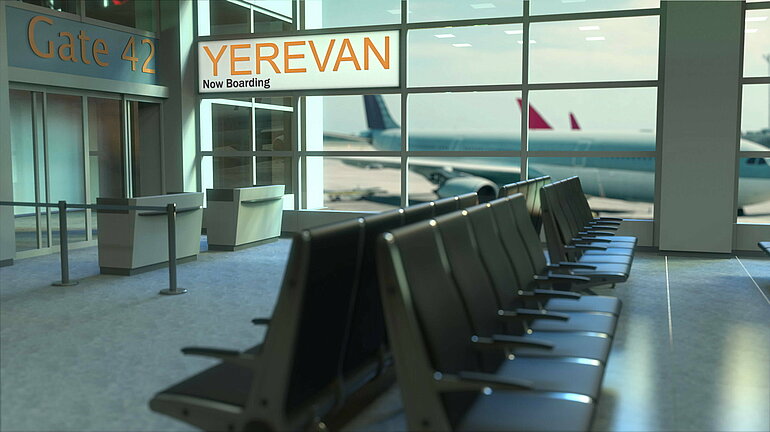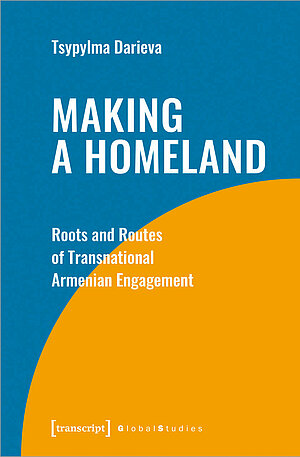‘Diasporic engagement with the homeland remains pluralist, ambiguous, and de-centralised’

Since the 1990s, many young members of the Armenian diaspora have volunteered in the Republic of Armenia. In her monograph, Tsypylma Darieva critically examines their motivations and asks what the direct encounter with the ancestral homeland means for their identity and political socialisation.
What do you mean by ‘roots mobility’ in your book and what makes Armenia an interesting case for studying it?
Migration flows are, of course, a major focus of current global debates, and in my book I look at a particular form of transnational mobility that I call diasporic ‘roots mobility’. ‘Roots’ here stands for heritage and ethnic origins, and ‘mobility’ for movement towards and engagement with a specific place: the ‘ancestral homeland’. Armenia has traditionally been a country of emigration and has a large diaspora, but until the 1990s contact with the homeland was difficult. After it gained independence in 1991, the Republic of Armenia became the focus of a new generation of diasporic organisations in the US seeking to engage with the homeland through activities like volunteering, travel, and investment. Since then, many young adults of Armenian heritage have made ‘meaningful’ trips to the homeland via organisations like Birthright Armenia and the Armenian Volunteer Corps. These young people feel an emotional attachment to Armenia, even though in some cases their descendants actually came from parts of the former Ottoman Empire now located in Turkey. In my book I look at what motivates them to travel and how they experience the mythical homeland on the ground. I was also interested in how this kind of diasporic mobility – which is sometimes conflated with heritage tourism – shapes the identity and political socialisation of young members of the Armenian diaspora.
Who are the ‘roots’ migrants who come to Armenia and what are their motivations?
It is a heterogeneous group in terms of geography and social and cultural background. However, most of them come from the USA and Canada. Interestingly, family isn’t usually the main factor in their decision to volunteer in Armenia; it’s more likely to be a school, a hometown association, the local Armenian church or Facebook networks. Roots migrants include volunteers, young professionals, diaspora activists and students, and they tend to come from urban, middle-class and multi-ethnic backgrounds.
Their motivations for coming to Armenia are varied. It may be the symbolic act of touching something sacred that their parents have talked about; the moral obligation to ‘give back’; the promise of adventure; the desire to ‘make the world a better place’; or the opportunity to exercise their skills in a new environment. Emotional attachment to the homeland certainly plays a role, but a close examination of the young people's statements shows that two motives predominate among the volunteers: the desire to improve their own career prospects and the desire to have an adventure in a remote place. So their motives are not purely altruistic, and diasporic volunteers are very aware of mobility as a ticket to improve their social status within the society in which they grew up.
What if any effects have the ‘roots’ migrants had on Armenia’s economic, social and political development?
The discourse around roots mobility sometimes implies that Western diasporic Armenians will contribute to the economic and political development of Armenia. But I am a bit sceptical about that. Young representatives of the Armenian diaspora have been successfully mobilised to discover and travel to the homeland, but their trips are individual, project-based and not particularly strategic. These young people frame their activities as an individual exchange with the homeland and seek out niches of engagement that aren’t controlled by the Armenian state. Many of them choose to work in selected ‘homeland’ localities, for instance in a city neighbourhood, in a village, at a school, or in a social programme. This can have an impact at a local level, but generally I found it difficult to detect effects on Armenia’s overall development. If anything, the effects are felt more in the countries they come from, where the volunteers’ experiences help keep diasporic spirit alive.
Successive governments of the Republic of Armenia have been very keen to attract members of the diaspora and tap into their material and intellectual resources. A law on dual citizenship was introduced in 2006 and the Ministry of Diaspora was founded shortly afterwards. It has since been renamed the High Commissioner for Diaspora Affairs. 2018 was declared the year of ‘spiritual’ repatriation to the Republic of Armenia and state institutions appealed to ethnic Armenians living abroad to return to the ancestral homeland at least ‘virtually’ and ‘temporarily’ by ‘living in Armenia and working abroad’, ‘opening a bank account in the homeland’ and ‘spending vacations in Armenia every three years’. The success of these initiatives has so far been quite limited. While the diasporic Armenians they target may consider themselves ethnically Armenian, many do not feel politically connected to the Republic of Armenia and define themselves beyond the parameters of one nation state. For now, diasporic engagement with the homeland remains pluralist, ambiguous, and de-centralised.
Can you talk about the clash of values that sometimes occurs when diasporic actors experience the homeland first-hand?
Apart from differences in language, culture and political values, there is an imbalance in power relations between the relatively wealthy roots migrants and the local Armenian population. This sometimes fuels a sense of disillusionment and a lack of mutual trust. For example, some of the young volunteers I spoke to had a strong feeling of reconnection to the territory of Armenia, while others sensed a deepening gap between two worlds. Some diasporic projects do not yield the expected outcomes and remain ‘one-sided’, bringing moral benefits to the volunteers rather than the hoped for changes to impoverished Armenia.

Is Russia’s war against Ukraine having any noticeable effects on the programmes you describe?
Yes it is. Programmes that facilitate a ‘return’ of the Armenian diaspora to the homeland have seen a surge in applications from people of Armenian descent in Russia, who seek to escape the Putin regime and partial mobilisation. This could strengthen diasporic mobilisation. In Armenian communities in the US, Canada, and Europe, activists are appealing for more homeland engagement and cooperation beyond the current ad hoc charity, tourism, and social media activism. The Second Karabakh War in 2020 prompted a temporary shift in the scope and repertoire of diasporic solidarity with the homeland, and it will be interesting to see how the political meaning of roots mobility and its effects on Armenian society change in the context of Russia’s war against Ukraine.
The interview was conducted by Anne Boden, Editor at ZOiS.
PD Dr. Tsypylma Darieva is head of the Research Cluster Migration and Diversity at ZOiS.
Darieva, Tsypylma. Making a Homeland. Roots and Routes of Transnational Armenian Engagement. Bielefeld: transcript Verlag, 2023.